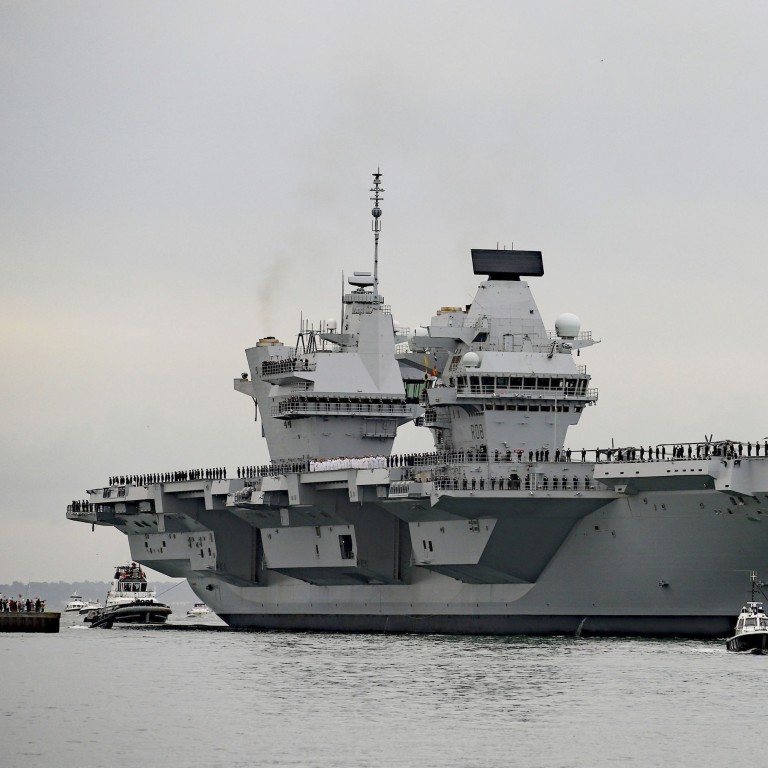
Britain urges the West to be ready to flex military muscle in the Pacific as US Navy steps up activities in South China Sea
- Hardline message could be part of face-saving effort to regain confidence battered by Brexit, Chinese analyst says
Western powers should be prepared to back their interests with military power just as Britain is prepared to send its new aircraft carrier to the Pacific, British Defence Secretary Gavin Williamson said on Monday.
Speaking in London at the Royal United Services Institute, a British think tank, Williamson said Western allies must be prepared to “use hard power to support our interests”, and failing to intervene against aggressive foreign powers “risks our nation being seen as little more than a paper tiger”.
He confirmed that the HMS Queen Elizabeth, the Royal Navy’s only active aircraft carrier, was being deployed to the Pacific, where China has been involved in a dispute over territorial claims in the South China Sea.
He said the carrier, which will become the centrepiece of Britain’s navy when it enters service by 2020, would take part in the mission along with F-35 jets from both Britain and the United States, adding that Britain should increase the “mass and lethality” of the country’s forces.
Williamson’s hardline message came as the US Navy steps up its activities in the South China Sea. On Monday, the US destroyers USS Spruance and USS Preble entered waters within 12 nautical miles of Mischief Reef, a Chinese-controlled artificial island in the disputed Spratlys.
The vessel’s presence immediately drew a sharp rebuke from the Chinese foreign ministry, which said the US should immediately stop “provocative actions” that violated Chinese sovereignty.
Wang Yiwei, professor in international relations at Renmin University in Beijing, said Britain’s operations would be different from those by the Americans, although Britain, as a key US ally, had its role to play.
Beijing insists on ‘indisputable sovereignty’ over South China Sea islands
Wang said Williamson’s remarks could be more of a face-saving move as Britain wrestled with its future, particularly in the aftermath of Brexit, adding that as a former global empire, Britain also had former colonies and residual interests and influence in the region.
“The main motive of British politicians is to salvage damaged confidence in the country’s future as Brexit … has caused huge uncertainty. They are trying to demonstrate strength and power,” he said.
Britain has repeatedly stated its intention to increase its activities in Asian waters and has carried out joint operations with the US. In January, the HMS Argyll frigate joined the USS McCampbell destroyer for six days of drills and operations in the South China Sea.
The exercise came just after the USS McCampbell completed another “freedom of navigation operation” near the Chinese-controlled Paracel Islands.
China Coast Guard heads to front line to enforce Beijing’s South China Sea claims
In August, the Royal Navy conducted its first freedom of navigation operation, sending the amphibious transporter HMS Albion to patrol near the contested Paracel Islands.
Four months later, Williamson announced plans to build a military base in the region, possibly in Singapore or Brunei, to have a more permanent presence in the western Pacific.
Wang said such a move would have negative consequences but not a dramatic impact on ties between China and Britain.
“Cooperation is more than predominant between the two sides, and China would not want more enemies,” he said.
As early as 2017, then British foreign secretary Boris Johnson had said the HMS Queen Elizabeth would patrol the South China Sea as soon as it was deployed.
Commissioned in December 2017, the conventional-powered 65,000-tonne carrier has a ski-jump flight deck and can carry up to 36F-35B Lightning stealth fighter jets and 4 helicopters.

